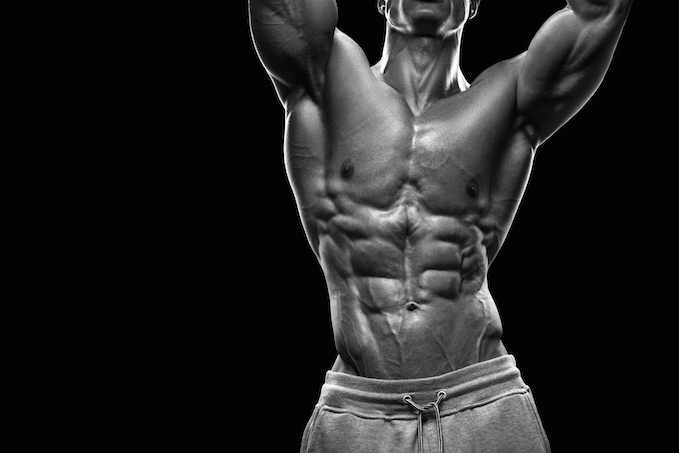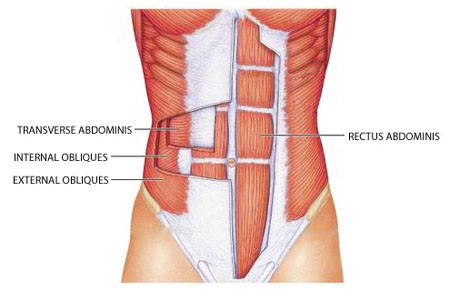The Anatomy Of Your Abdominal Muscles

When you think of abs, what muscle do you typically think of?
This might sound like a strange question, right?
I mean, the abs are the muscle.
You go to the gym to train your abs.
But in actuality there are 4 separate muscles that contribute to your overall abdominal development.
Here is a diagram that shows where each one is located:

The 4 distinct muscles that make up your abs.
Each of these 4 muscles has a different, yet important, role to play – so you want to make sure that your workouts train all of them effectively.
Together, these muscles will impact your core stability, strength, your posture, in addition to providing many other important functions.
Let’s quickly go through each of them, one by one.
Rectus Abdominis

Rectus abdominis muscle (shaded in red)
When people generally think of a ‘six-pack’, this is the muscle that they are talking about…
The rectus abdominis is positioned between the ribs and the pubic bone at the front of the pelvis, and is actually made up of 8 distinct muscle bellies.
When the muscle contracts, these muscle bellies are visible, assuming low enough levels of body fat, creating that ‘six-pack’ look.
The rectus abdominis is absolutely essential for maintaining good posture, and is primarily responsible for flexing the lumber spine (the movement of a sit-up or a crunch).
This muscle can be worked out in 2 different ways: by either bringing the chest towards the pelvis (as with a crunch), or by bringing the pelvis towards the chest (as with a leg raise).
This is what people mean when they say they’re working their ‘upper’ or ‘lower’ abs.
Finally, the rectus abdominis also helps to regulate breathing, and protects your internal organs by creating intra-abdominal pressure.
External Obliques

External oblique muscles (shaded in red)
After the rectus abdominis, the obliques are probably the one other abdominal muscle that many people focus on.
However, what you may not know is that there are actually 2 distinct sets of oblique muscles: your external obliques and your internal obliques (which I’ll discuss in a second).
Your external obliques sit on either side of your rectus abdominis, and are actually the largest of your abdominal muscles.
This is the muscle that allows the trunk of your body to twist – this is controlled by the external oblique muscle on the opposite side of the direction that you’re twisting.
For instance, if you are twisting to the left, you are using your right external oblique.
The external obliques also help with your overall posture, pulling your chest downwards, and protecting your organs by creating intra-abdominal pressure (just as with the rectus abdominis).
Internal Obliques

Internal oblique muscles (shaded in red)
Now you can think of this muscle as kind of being the opposite of the external oblique.
They are located directly below the rectus abdominis, and sit just inside your hip bones.
The internal obliques are also responsible for twisting and turning, but they control the other side of the movement.
For example, when you twist to the right, you are contracting both your right internal oblique and your left external oblique at the same time.
Since they control the movement on the same side of your body, internal obliques are sometimes referred to as “same side rotators”.
Transverse Abdominis

Transverse abdominis muscle (shaded in red)
In my experience, the vast majority of people have never heard of this muscle.
I mean, you’ve probably never heard anyone at the gym saying that they are working out their transverse abdominis today…
Still, it is a very important muscle, which is integral to holding your entire abdominal structure together.
The transverse abdominis is the ‘deepest’ of your ab muscles, located underneath your rectus abdominis and obliques.
However, even though you’ll never see this muscle visually, it is incredibly important to maintaining a functionally strong core and for creating large amounts of stabilizing internal abdominal pressure.
Respect Your Core

Now, I’ve mentioned core before, but didn’t really stop to define it…
Basically, you can think of each of the abdominal muscles that we’ve discussed coming together to form your core (in addition to some muscles in your lower back, but I’ll discuss those another time).
Core strength is becoming increasingly emphasized as a fundamental component of any good fitness program.
Without a strong core, you simply don’t have the stable structure required to train the rest of the body as effectively.
Not to mention moving around properly and enjoying your life!
So, now you’re probably wondering how you should go about training each of these muscles properly.
There are a million ab exercises out there, but which ones are best in terms of effectively targeting each of these unique muscles?
Well, that is unfortunately beyond the scope of this article; however, I promise that I’ll address that question and more in my follow-up article next week.